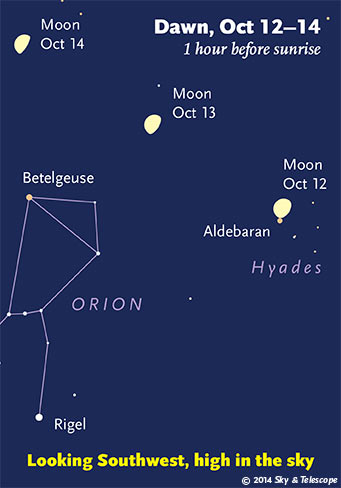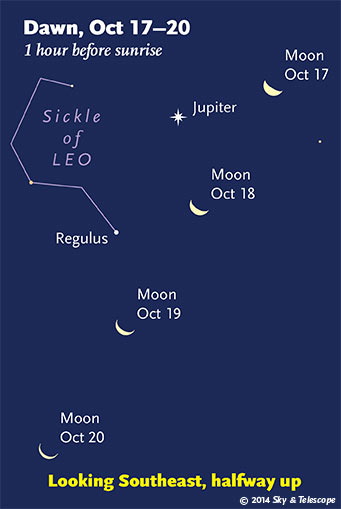Some daily sky sights among the ever-changing stars and planets
Friday, October 10
The waning gibbous Moon is up in the east by 9 or 10 p.m. Look left of it (by about a fist-width at arm's length) for the Pleiades. Much farther left, in the northeast, shines Capella in Auriga.
High above the Moon and Capella, forming a big triangle with them, is the naked-eye eclipsing variable star Algol. It should be at its minimum light, magnitude 3.4 instead of its usual 2.1, for a couple hours centered on 12:36 a.m. tonight EDT; 9:36 p.m. PDT. Algol takes several additional hours to fade and to recover. Info and comparison-star chart.

Saturday, October 11
The Moon late this evening shines near Aldebaran amid the Hyades. Take a look with binoculars. This will be a challenging scene to photograph (use a long lens), what with the Moon's brilliance and the Hyades stars' faintness. By dawn they've moved over to high in the southwest.
Sunday, October 12
Orion preview: With fall well underway, the "winter" constellation Orion rises in the east by 11 or midnight, depending on how far east or west (respectively) you live in your time zone. It's well to the lower right of the waning Moon. Orion's Belt will be vertical, as it always is when Orion is rising for mid-northern skywatchers. Orion reaches its highest stand in the south well before the first light of dawn, with the Moon now above it (on the morning of the 13th).
Monday, October 13
As twilight fades, look for Arcturus, the Spring Star, twinkling in the west to west-northwest. It's still pretty easy to see. But how much later into the fall, as it sinks away, will you be able to keep it in view?
Tuesday, October 14
Now that it's mid-October, Deneb has replaced Vega as the zenith star after nightfall (for skywatchers at mid-northern latitudes) — and, accordingly, Capricornus has replaced Sagittarius as the most notable constellation low in the south.
Wednesday, October 15
Last-quarter Moon (exactly so at 3:12 p.m. Eastern Daylight Time). The Moon rises around midnight tonight, below Gemini. By early dawn on Thursday the 16th it's very high in the south — with Pollux and Castor above it, Procyon to its lower right, and bright Jupiter shining farther to its lower left.

Thursday, October 16
Dawn and sunrise come quite late now as the season advances. On Friday morning the 17th, before the sky gets too bright, you'll find Jupiter to the left of the waning Moon, and Procyon farther to the Moon's right.
Friday, October 17
Before dawn Saturday morning, Jupiter shines above the waning Moon. Although they look rather close together, Jupiter is 2,100 times farther in the background — at a distance of 47 light-minutes, compared to the Moon's 1.3 light-seconds.
Saturday, October 18
This is the time of year when, after nightfall, W-shaped Cassiopeia stands on end halfway up the northeastern sky — and when, off to its left, the dim Little Dipper extends leftward from Polaris in the north.
On Sunday the 19th, the faint Comet Siding Spring (C/2013 A1) makes its much-awaited close pass by Mars, as told in the September Sky & Telescope, page 53, with chart. This will be an extremely challenging observation, with Mars low in the southwest right at the end of twilight and the comet only 10th or 11th magnitude, fainter than originally predicted. But you can follow a webcast of the encounter courtesy of the Virtual Telescope project; watch in real time starting at 16:45 UT (12:45 p.m. EDT) October 19th, or the recording later. Also: NASA Prepares Its Science Fleet for Oct 19 Mars-Comet Encounter.
Want to become a better astronomer? Learn your way around the constellations. They're the key to locating everything fainter and deeper to hunt with binoculars or a telescope.
This is an outdoor nature hobby; for an easy-to-use constellation guide covering the whole evening sky, use the big monthly map in the center of each issue of Sky & Telescope, the essential guide to astronomy. Or download our free Getting Started in Astronomy booklet (which only has bimonthly maps).

Once you get a telescope, to put it to good use you'll need a detailed, large-scale sky atlas (set of charts). The standards are the little Pocket Sky Atlas, which shows stars to magnitude 7.6; the larger and deeper Sky Atlas 2000.0 (stars to magnitude 8.5); and once you know your way around, the even larger Uranometria 2000.0 (stars to magnitude 9.75). And read how to use sky charts with a telescope.
You'll also want a good deep-sky guidebook, such as Sue French's Deep-Sky Wonders collection (which includes its own charts), Sky Atlas 2000.0 Companion by Strong and Sinnott, the bigger Night Sky Observer's Guide by Kepple and Sanner, or the beloved if dated Burnham's Celestial Handbook.
Can a computerized telescope replace charts? Not for beginners, I don't think, and not on mounts and tripods that are less than top-quality mechanically (able to point with better than 0.2° repeatability, which means fairly heavy and expensive). As Terence Dickinson and Alan Dyer say in their Backyard Astronomer's Guide, "A full appreciation of the universe cannot come without developing the skills to find things in the sky and understanding how the sky works. This knowledge comes only by spending time under the stars with star maps in hand."
This Week's Planet Roundup
Mercury and Venus are hidden in the glare of the Sun.
Mars (magnitude +0.8) remains low in the southwest during dusk. Look for twinklier orange Antares (magnitude +1.0) moving ever farther down to Mars's lower right.
Jupiter (magnitude –1.9, at the Cancer-Leo border) rises in the east-northeast around 2 a.m. It shines brightly high in the east before and during dawn. Jupiter forms a big triangle with Pollux above it (by about two fists at arm's length) and Procyon to their right. Below Jupiter and a bit left is Regulus.
Saturn (magnitude +0.6, in Libra) is sinking very low after sunset. As twilight fades, look for it well to the right of Antares, which is lower right of Mars. Bring binoculars.
Uranus (magnitude 5.7, in Pisces) and Neptune (magnitude 7.8, in Aquarius) are high in the southeast and south, respectively, by 9 or 10 p.m. See our finder charts for Uranus and Neptune online or in the September Sky & Telescope, page 50.
All descriptions that relate to your horizon — including the words up, down, right, and left — are written for the world's mid-northern latitudes. Descriptions that also depend on longitude (mainly Moon positions) are for North America.
Eastern Daylight Time (EDT) is Universal Time (UT, UTC, or GMT) minus 4 hours.
“This adventure is made possible by generations of searchers strictly adhering to a simple set of rules. Test ideas by experiments and observations. Build on those ideas that pass the test. Reject the ones that fail. Follow the evidence wherever it leads, and question everything. Accept these terms, and the cosmos is yours.”
— Neil deGrasse Tyson, 2014.
 1
1
Comments
Joe Slomka
October 10, 2014 at 4:26 pm
RE: Mars-Comet Encounter
The article and accompanying star chart is in the OCTOBER S&T, page 53. Not September.
I looked it in my own hard copy magazine.
You must be logged in to post a comment.
You must be logged in to post a comment.